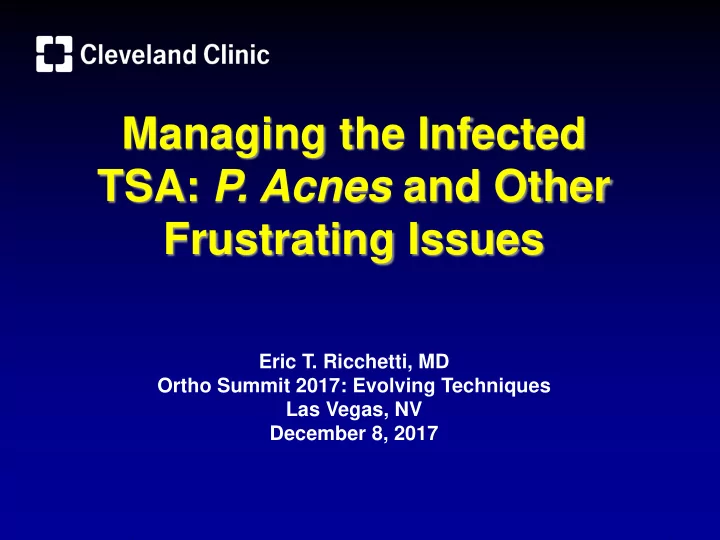

Managing the Infected TSA: P. Acnes and Other Frustrating Issues Eric T. Ricchetti, MD Ortho Summit 2017: Evolving Techniques Las Vegas, NV December 8, 2017
I have something to disclose. Detailed disclosure information is available via: “My Academy” app; My Academy Printed Final Program; or AAOS Orthopaedic Disclosure Program on the AAOS website at http://www.aaos.org/disclosure
The Challenge • P. acnes is the most common pathogen in revision shoulder arthroplasty. • Revision shoulder arthroplasty ~50% positive culture rate • Due to its indolent nature, infection can be difficult to evaluate, diagnose, and treat. - Subtle, non-specific clinical picture with delayed, chronic presentation - Pain ± stiffness Topolski et al, JSES 2006; Kelly & Hobgood, CORR 2009; Foruria et al, JSES 2013 Piper et al, J Clin Micro 2009; Singh et al, JSES 2012; Pottinger et al, JBJS 2012; Ricchetti et al, JBJS Reviews 2014; Grosso et al, JSES 2012; Grosso et al, JSES 2014; Frangiamore et al, JBJS 2015 (a & b); Frangiamore et al, JSES 2015
Evaluation • Diagnostic work-up of a painful shoulder arthroplasty: - History & Physical - Imaging - Serum ESR & CRP - Preoperative aspiration - Intraoperative culture & pathology • Not overtly positive in many cases.
Evaluation • Risk factors for PJI of the shoulder: - Male gender ( P. acnes ) - Postoperative hematoma - Prior shoulder surgery (non- arthroplasty, arthroplasty) - Age - Humeral and/or glenoid component loosening, osteolysis (early) Cheung et al, JBJS 2008; Singh et al, JSES 2012; Pottinger et al, JBJS 2012; Richards et al, CORR 20014; Hou et al, JSES 2015; Nelson et al, JSES 2016; Werthel et al, JSES 2016
Preoperative Serum Markers • Low sensitivity of standard serum markers due to indolent pathogens, but good specificity: - Serum ESR sensitivity & specificity: • Hip & knee PJI: 75-89%, 69-74% • Shoulder PJI: 21-42%, 65-93% - Serum CRP sensitivity & specificity: • Hip & knee PJI: 74-97%, 74-97% • Shoulder PJI: 0-63%, 73-95% Piper et al, PloS ONE 2010; Berberi et al, JBJS 2010; Jacovides et al, J Arthroplasty 6 2011; Deirmengian et al, JBJS 2014; Villacis et al, JBJS 2014; Grosso et al, JSES 2014
Culture Analysis • No standardized protocol for preoperative & intraoperative culture sampling & analysis: - Under sampling common in literature. - Factors impacting P. acnes recovery: • Preoperative antibiotic hold • Fluid vs. periprosthetic tissue specimens • Culturing technique (anaerobic, implant sonication) • Culture length: 7-28 days • Optimal intraoperative culture protocol: - Ability to interpret significance of a positive culture result: true positive vs. contaminant. - 4-5 tissue specimens, 14-17 day culture hold Piper al, J Clin Micro 2009; Butler-Wu et al, J Clin Micro 2011; Pottinger et al, JBJS 2012; Matsen et al, JBJS 2013; Mook et al, JBJS 2014; Hou et al, JSES 2015; Hsu et al, JBJS 2016; Ahsan et al, JBJS 2017
Significance of Positive Culture • Frangiamore et al, JBJS 2015: Evaluated 46 revision shoulder arthroplasty cases with ≥1 P. acnes positive culture - Two culture groups based on periprosthetic shoulder infection criteria: • Probable true positive group • Probable contaminant group - Time to culture growth significantly shorter in probable true positive culture group (median, 5 vs. 9 days, p=0.002). - Regardless of group classification, significantly fewer days to P. acnes culture growth: • Cases with higher number of positive cultures • Case with higher proportion of positive cultures
Treatment • Even if diagnosis of PJI can clearly be made, treatment algorithm still not clearly defined in chronic indolent setting: - Diagnosed before or at time of surgery: • One-stage revision arthroplasty with postoperative antibiotics • Two-stage reimplantation - Diagnosed after post-op culture growth: • One-stage revision arthroplasty • Need for and length of post-op antibiotics
Treatment • Nelson et al, JSES 2016: Systematic review of outcomes in treatment of shoulder PJI - 30 studies, 669 patients - P. acnes most common bacteria (38.9%) - PJI eradication rates: • Resection arthroplasty: 93.3% (n=90) • Antibiotic spacer only: 90.3% (n=31) • One-stage with UPC: 90.1% (n=282) • One-stage without UPC: 91.7% (n=72) • Two-stage: 93.8% (n=97) • Antibiotic suppression: 50% (n=8) • I&D with implant retention: 68.6% (n=35)
Treatment • Good outcomes & infection eradication reported with both one- and two-stage revisions, but difficult to draw definitive conclusions: - Small numbers per study - Often non-comparative - Varying treatment protocols - Varying follow-up - Lack of uniform criteria for choosing one- vs. two-stage revision Ince et al, JBJS Br 2005; Cuff et al, JBJS Br 2008; Beekman et al, JBJS Br 2010; Hattrup & Renfree Orthop 2010; Cofffey et al, JSES 2010; Sabesan et al, CORR 2011; Klatte et al, Bone JJ 2013; George et al, BMC MSK 2016; Nelson et al, JSES 2016; Stone et al, JSES 2017
Treatment • Hsu et al, JBJS 2016: One-stage revision in P. acnes positive revision shoulder arthroplasty - Retrospective comparison of clinical outcomes of cases without evidence of infection at minimum 2 year follow-up (47.8±11.8 months): • 27 cases with ≥ 2 P. acnes positive cultures • 89% male (p<0.001), mean age 63.5±7.2 yrs • Controls: 28 cases with no or 1 P. acnes positive culture • 39% male, mean age 67.1±8.1 yrs - No difference in pain and functional improvement between groups. • No difference in revision surgeries between groups, no revisions for infection. • Antibiotic side effects in 42% (14/33)
Summary: Treatment Algorithm • Two-stage revision: Positive preoperative synovial aspirate, early humeral loosening, intraoperative gross findings, positive intra-operative frozen sections - Subset of patients consider one-stage? • One-stage revision: Negative pre- and intra-operative work-up - Discharge on oral antibiotic until cultures final at two weeks - If late growth of only one positive culture, all other testing is negative: consider no further treatment if all components removed & used antibiotic cement. - If early growth of one positive culture or multiple positive cultures: convert to 6 weeks IV antibiotics ± period of oral antibiotic (duration unknown).
Recommend
More recommend